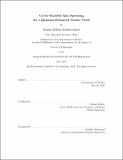Cavity-enabled spin squeezing for a quantum-enhanced atomic clock
Author(s)
Schleier-Smith, Monika Helene
DownloadFull printable version (2.531Mb)
Other Contributors
Massachusetts Institute of Technology. Dept. of Physics.
Advisor
Vladan Vuletić.
Terms of use
Metadata
Show full item recordAbstract
For the past decade, the stability of microwave atomic clocks has stood at the standard quantum limit, set by the projection noise inherent in measurements on ensembles of uncorrelated particles. Here, I demonstrate an atomic clock that surpasses this limit by operating with atoms in a particular type of entangled state called a "squeezed spin state." The generation of non-classical spin correlations in a dilute cloud of atoms is facilitated by an optical cavity, which allows for strong collective coupling of the atomic ensemble to a single mode of light. Since the light exiting the cavity is entangled with the atoms, an appropriate measurement performed on the light field can project the atomic ensemble into a squeezed spin state. I demonstrate 3.0(8) dB of spin squeezing by this method of quantum non-demolition measurement. I further introduce a new method, cavity feedback squeezing, which uses the light field circulating in the resonator to mediate an effective interaction among the atoms. The light-mediated interaction mimics the spin dynamics of the one-axis twisting Hamiltonian, under which a coherent spin state evolves deterministically into a squeezed spin state. The states prepared by cavity feedback are intrinsically squeezed by up to 10(1) dB and detectably squeezed by up to 5.6(6) dB. Applied in an atomic clock, they produce an Allan variance 4.7(5) dB below the standard quantum limit for averaging times of up to 50 s. In a detour from engineering collective spin dynamics, I present direct observations of collective motional dynamics of atoms under the influence of cavity cooling. I demonstrate cooperatively enhanced cooling of a single collective motional mode down to a mean occupation number of 2.0 (-0.3/+0.9) phonons. The cooling is quantitatively well described by a simple, analytic quantum optomechanical model.
Description
Thesis (Ph. D.)--Massachusetts Institute of Technology, Dept. of Physics, 2011. Cataloged from PDF version of thesis. Includes bibliographical references (p. 127-135).
Date issued
2011Department
Massachusetts Institute of Technology. Department of PhysicsPublisher
Massachusetts Institute of Technology
Keywords
Physics.